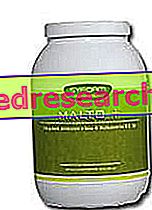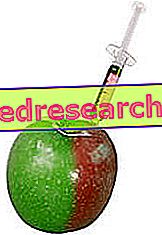What's this
What is mascarpone cream?
Mascarpone cream is a typical Italian dessert based on: mascarpone, sugar, water, egg yolks and possibly bitter cocoa. It is used as a dessert or as an ingredient for other desserts, especially the famous tiramisu.

Hypercaloric, hyperlipidic and rich in both sugar and cholesterol, the mascarpone cream is rightly considered by most to be the anti-dietetic recipe by definition. Certainly, even in the nutritional regime of healthy people and in normal weight, this food should play a marginal role, with reduced portions and sporadic consumption frequency.
Moreover, in its traditional version the mascarpone cream provides for the use of raw egg yolks and mascarpone, being totally unsuitable for those who are in special or more vulnerable conditions - for example pregnancy, immunosuppression, early childhood, old age with poor health, etc. The potential for microbiological development of these ingredients means that the mascarpone cream, also impeccably produced and preserved, should not be consumed more than 48 hours after packaging.
Mascarpone cream is a recipe for vegetarian omnivores and lacto-ovo, although there is the possibility of using a vegetable mascarpone or modifying the recipe eliminating both eggs and yolks - see Alice's recipe: Tiramisù Light Without Mascarpone and Tuorli .
A good mascarpone cream has a creamy, non-gelatinous consistency, and distinctly recalls the organoleptic and gustatory characteristics of raw egg yolks and mascarpone. If it is too thick and thick, perhaps it has been added with isinglass which ensures greater stability. If separated instead, it could be old or incorrectly produced.
Mascarpone cream is an extremely delicate food from a microbiological point of view. It is one of the most statistically responsible recipes for food poisoning, in particular salmonellosis - Salmonella paratyphi - and staffilococcal enterotoxicosis - Staphylococcus aureus . For this reason it is advisable to use only pasteurized egg yolks, check the expiration date of the mascarpone, pay attention to the possibility of contamination, keep the mascarpone cream at a low temperature and no more than one or two days.
Tiramisu with Pasteurized Eggs - Light Version
X Problems with video playback? Reload from YouTube Go to Video Page Go to Video Recipes Section Watch the video on youtubeNutritional Properties
Nutritional properties of mascarpone cream
Mascarpone cream is a very energetic recipe. Calories come mainly from lipids, followed by carbohydrates and finally proteins. Fatty acids are mostly saturated, soluble glucides - sucrose and lactose - and peptides with high biological value - that is, they contain all the essential amino acids in the right quantities and proportions with respect to the human protein model.
Mascarpone cream contains cholesterol in high quantities, while it is free of dietary fiber and gluten. The levels of histamine are theoretically moderate - even if the eggs are potentially histamine-liberators - as well as those of purines and amino acid phenylalanine; the amount of lactose is significant instead.
As for the vitamins, the mascarpone cream provides useful levels, even if not exciting, of various water-soluble B-groups - such as riboflavin or vit B2 and pyridoxine or vit B6 - but also of liposoluble such as calciferol (vit D) and retinol equivalents (vit A and carotenoids). With regard to mineral salts, on the other hand, iron and phosphorus concentrations appear to be fairly good.

| Nutritious | Quantity' |
| water | 39.091 g |
| Protein | 6.53 g |
| Lipids | 33.2 g |
| Saturated fatty acids | 19.92 g |
| Monounsaturated Fatty Acids | 11.06 g |
| Polyunsaturated Fatty Acids | 1.50- g |
| Cholesterol | 185.15 mg |
| TOT Carbohydrates | 16.66 g |
| Starch / Glycogen | - g |
| Soluble Sugar | 16.34 g |
| Food fiber | 0.0 g |
| Soluble | 0.0 g |
| Insoluble | 0.0 g |
| Power | 384.2 kcal |
| Sodium | 60.75 mg |
| Potassium | 45.65 mg |
| Iron | 0.40 mg |
| Football | 57.95 mg |
| Phosphorus | 102.5 mg |
| Magnesium | - mg |
| Zinc | 0.49 mg |
| Copper | - mg |
| Selenium | - mcg |
| Thiamine or vitamin B1 | 0.02 mg |
| Riboflavin or vitamin B2 | 0.20 mg |
| Niacin or vitamin PP | 0.07 mg |
| Vitamin B6 | 0.06 mg |
| folate | 14.60 mcg |
| Vitamin B12 | - mcg |
| Vitamin C or Ascorbic Acid | 0.0 mg |
| Vitamin A or RAE | 267.55 RAE |
| Vitamin D | 10.70 IU |
| Vitamin K | - mcg |
| Vitamin E or Alpha Tocopherol | 0.91 mg |
Diet
Role of mascarpone cream in the diet
Mascarpone cream is a preparation that does not lend itself to all diets; it is not recommended especially in the case of overweight and metabolic pathologies. Moreover, even in the diet of healthy people, it should play a marginal role, with extremely limited portions and frequency of consumption.
Being a hyper-calorie and hyperlipidic recipe, the mascarpone cream should be totally avoided in the obese diet. Due to the high percentage of fatty acids and high cholesterol content, this preparation cannot be part of the diet against hypercholesterolemia. Even the significant amount of simple sugars has not a few contraindications, among which above all a non-compliance with nutritional therapy for hyperglycemia and type 2 diabetes mellitus, hypertriglyceridemia, fatty liver steatosis and a tendency to tooth decay.
Proteins have a high biological value but are not particularly abundant. Moreover, given the contraindications of the case, this recipe cannot be considered as a primary source of essential amino acids.
Mascarpone cream is not easily digestible and tends to make the meal very heavy. For this reason it is advisable to eat it away from lunch and especially from dinner. It is also totally not recommended in case of pathologies and discomforts related to the digestive system such as dyspepsia, gastritis, hypochloridria, gastroesophageal reflux disease and gastric or duodenal ulcer.
Containing lactose, mascarpone cream should be avoided in intolerance to milk sugar. Instead it is without contraindications for celiac disease, hyperuricemia and phenylketonuria. Since the eggs are histamine-free foods, the recipe could be contraindicated in the most serious intolerances to histamine.
Mascarpone cream is a good source of vit A or retinol equivalent (RAE), among which both retinol and carotenoids appear. This nutritional factor is essential for maintaining visual, reproductive function and efficient cell differentiation; carotenoids are powerful antioxidants. Thanks to the presence of yolk, the food also contains an excellent level of vitamin D or calciferol, necessary for bone metabolism and the correct functioning of the immune system, and quite rare in food. There is no shortage of water-soluble vitamins of group B - coenzymatic factors - which however are present in limited quantities, leaving the mascarpone cream as a necessary source for the maintenance of cells and tissues.
In the mascarpone cream you can appreciate the levels of bioavailable iron and phosphorus. While the former is necessary above all for the synthesis of hemoglobin, that is the group necessary for the constitution of red blood cells - a function which, if compromised, results in iron deficiency anemia - the second is a very diffused element in the whole organism, starting from cell membranes and from nerve sheaths (phospholipids), up to the bone mineral (hydroxyapatite).
The correct portion - but almost never respected - of mascarpone cream is 50 g (about 190 kcal).
Hygiene
Hygienic aspects of the mascarpone cream
The first clue that suggests a poor conservation of the mascarpone cream is the loss of consistency and the consequent separation, indicative of a molecular destabilization caused by aging and possibly accelerated by the bacterial metabolism. The second is the organoleptic and gustatory alteration, therefore the unpleasant or different intake of smell and taste.
The microbiological activity releases, in fact, almost always a series of compounds that are simple enough to warn - when sufficiently concentrated. Nevertheless, there are frequent cases in which consumption of mascarpone cream is attributed even serious food poisoning; the typical example is that of salmonellosis ( Salmonella paratyphi ), but episodes of staphylococcal enterotoxicosis ( Staphylococcus aureus ) are also frequent.
While the salmonellae are bacteria that mainly concern the raw materials, or are already present in the eggs - more often on the shell and contaminating the product only at the moment of the break - the staphylococci represent the main pathogenic agents that multiply due to cross-contamination - contact raw food with tools, work surfaces or dirty containers - or bad habits of kitchen staff - little hand hygiene, carelessness during sneezing or coughing etc.
Rarer, due to the extremely unpleasant odor that the contaminated and therefore easily identifiable food can give, are the food-borne diseases caused by coliform bacteria ( Escherichia coli ). These can reach and spread in the mascarpone cream both for the already presence on the shell of the eggs, and reaching it for cross contamination or inoculation of the kitchen staff; remember that they are the main microorganisms present in the faeces.
Instead, the possible presence of Listeria monocytogenes, potentially responsible for listeriosis, deserves a separate discussion. Generally harmless for normal subjects, it can have very serious consequences on the unborn child when it is infected by the pregnant woman - miscarriage, premature birth, death in the uterus or fetal infection. In that case, the only way to prevent foodborne illness is to stick to nutritional restrictions for pregnant women. In fact, listeria is potentially present in fresh and raw cheeses, in this case in mascarpone. To be sure, the chances of getting listeriosis are very low; just think that with a microbiological analysis of raw materials - starting raw milk - only 5% of the samples contain listeria and of these practically no one shows risky concentrations. Nevertheless, since the effects of listeriosis are almost irreversible as well as very serious, it is advisable to follow the guidelines for proper nutrition during pregnancy, ie avoiding to consume the mascarpone cream.
Description
Description of the mascarpone cream
A good mascarpone cream should have well-defined characteristics. The consistency is soft, creamy and frothy, absolutely not gelatinous or firm. The color may be variable, from a pale yellow if the yolks are slightly pigmented to the intense one if they are rich in provitamin A. The aroma and taste are typically fresh eggs and mascarpone; the prevailing taste is sweet but fresh, never acid, slightly bitter due to the presence of bitter caco.
Many inexperienced cooks correct the mascarpone cream with isinglass - food collagen - to make it thicker and more stable for a long time, or to prevent it from separating - an inconvenience that can arise even just a few hours after preparation. For an inexperienced consumer, the presence of this ingredient is almost impossible to detect; for a connoisseur of mascarpone cream instead, it makes it absolutely bad quality.
recipe
Mascarpone cream recipe
Mascarpone cream is not a particularly complex recipe, but to ensure an optimal result it must be carefully respected. Let's look at it in more detail.
Mascarpone cream ingredients
Mascarpone cream ingredients for 8 small portions:
- Mascarpone: 500 g
- Sugar: 125 g
- Egg yolks: about 80 g - 4 egg yolks
- Water: 50 ml
- Bitter cocoa: QB
Mascarpone cream procedure
- Mix sugar and water and, in a saucepan on the stove, bring to 121 ° C
- Turn off the heat and let the syrup cool down to 115 ° C; meanwhile whip the egg yolks
- Add the syrup to the egg yolks and continue whipping
- With the mixture well blended, add the mascarpone with a spatula incorporating from the bottom upwards
- Spit into cups or glasses and place them in the refrigerator
- Before serving, sprinkle over with a little bitter cocoa.



